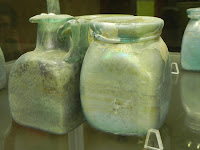Also kicking the bucket were a number of unfortunates that stuck around the city after the nearby volcano, Vesuvius, began showing serious signs of erupting. We have all seen the images of the city excavated from 20-25 feet of ash and soil and the items of daily life that were trapped and preserved by the eruption; but visiting it is a sober and amazing experience. Pompeii was a Roman town of an estimated 20,000 people, most of whom had left before the fireworks began. Excavations have been going on since it was discovered by workers digging a canal in 1748. Here are some of the things we saw while roaming around the huge site:
 |
 |
| A typical road, made of cut stone with elevated sidewalks. The stones in the center of the roadway are for crossing to keep one's ancient feet dry. |
Below is a temple that stands at one end of the Forum. Civic buildings were at the other, with a scattering of temples to gods that had fallen out of favor along the perimeter. Then, like now, gods often had the best real estate.
 |
 |
| A statue on one approach to the Forum. This warrier must have been pretty confident of his skills as the spear was the only thing he had on. |
You may have seen photos of Pompeii showing the plaster casts of people that sheltered in buildings. Abut 1000 "people" have been found. Mostly all that was left was their shape in the hard ash. Plaster was injected into the void to reveal the outline of people. It tells a pretty tragic story.
Warehouses at the site display some of the casts, and many, many objects found in the city. There are 1000s of ceramic vessels, plates, pottery, money, jewellery and all manner of stuff that were part of life when it came to a quick end 1900 years ago.
 |
 |
| Man's best friend also was found. |
 |
| A bread oven. Still standing after nearly 2000 years. Some ovens still had carbonized bread in them |
Houses, shops and businesses were all set in close quarters along most streets. Apparently zoning had not yet been discovered. Here is a road less travelled that held mostly houses, I think. Ruts in most roads are plainly visible worn by wagon traffic.
A couple houses had warning signs at their entrances, only being Romans they did it in a big way. Here is one mosaic that simply says "Beware of Dog". No dog was present when we visited however.
Pompeii citizens seemed to live pretty well and enjoyed access to large public baths, and to the right, one of two theatres. This one held only a couple thousand.
The really big shows took place in the coliseum. This one could fit about 20,000 people and here are the stairs to the cheap seats. It could be partially covered with awnings to provide shade and that comfy ambiance necessary for gladiatorial combat.
The space below the colosseum had access for people, props and animals. It was built for the long term like most Roman public structures.
 |
| The lower decks provided the best viewing and were used by today's equivalent of season ticket holders. |
 |
| Glass vessels were available when the good company dishes were needed. |
Houses were adorned with art, wall paintings and gardens. Below is a bronze of "the Fawn" from a large house. This statue sits in the shallow rain-fed basin located inside the entrance of most of the larger houses. Not sure if he is really happy to see guests or running from the family dog. . . .

Wall art was important and a feature of pretty much every home.
 |
| Here is a fresco, paint over plaster, from another home. This one shows a woman holding a head. Not sure what's up, but not very neighbourly. The head seems a bit surprised about this, too. |

 |
Finally - after food, head chopping, gladiatorial contests and just doing Roman stuff, what better way to end the day than with a good soak? Here is a bath from a house where you could relax, think big thoughts, and get ready for the next day that never came.
Pompeii was quite astounding, and shows how people lived and otherwise almost two millennia ago. These pictures show only a very small part of the town, and areas are still being excavated. It is definitely a bucket list kind of place, and the sights, both good and ghastly, tell an amazing story.
Al













No comments:
Post a Comment